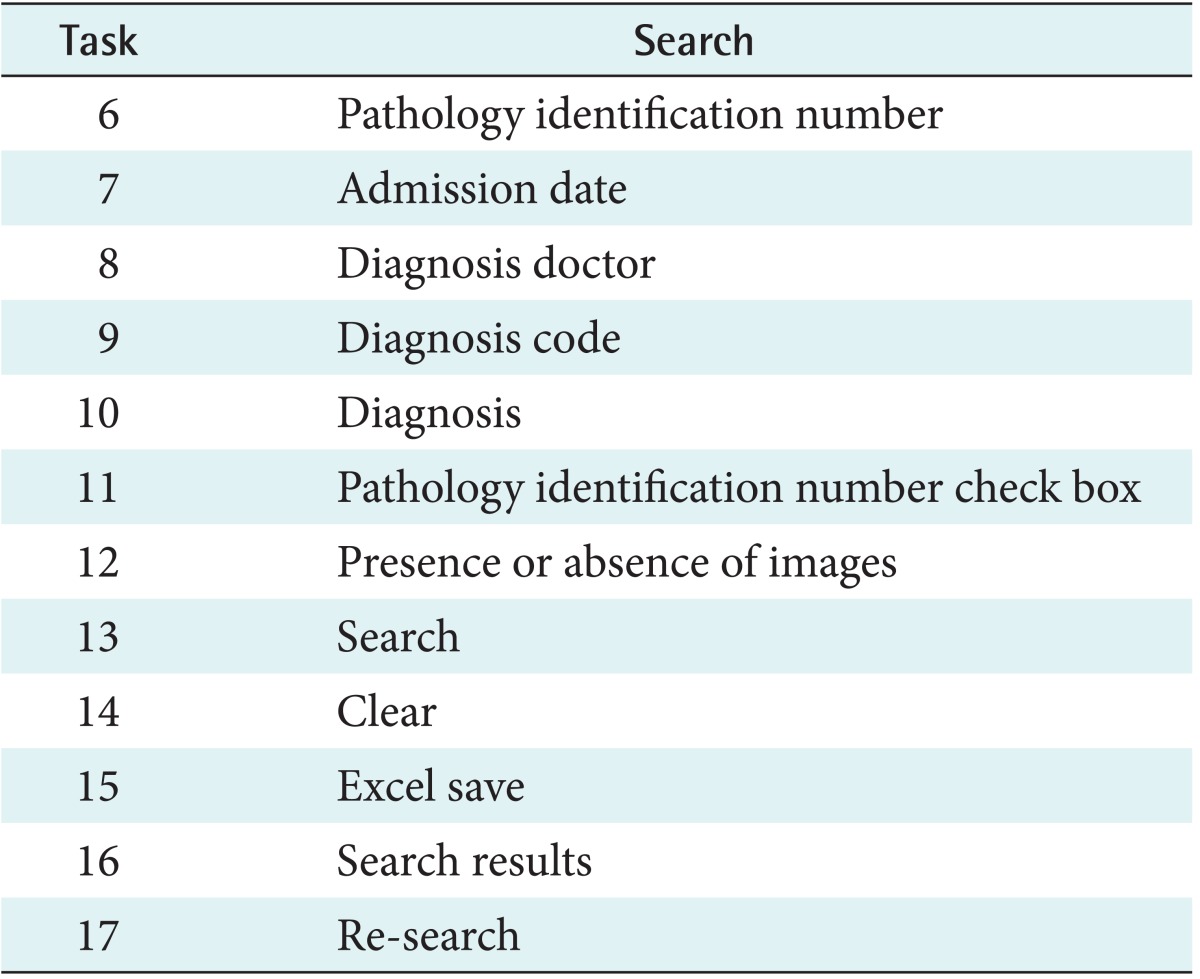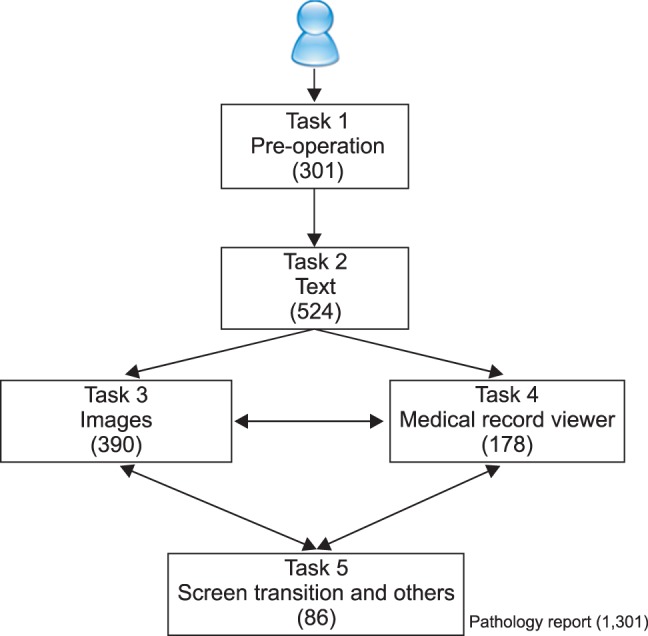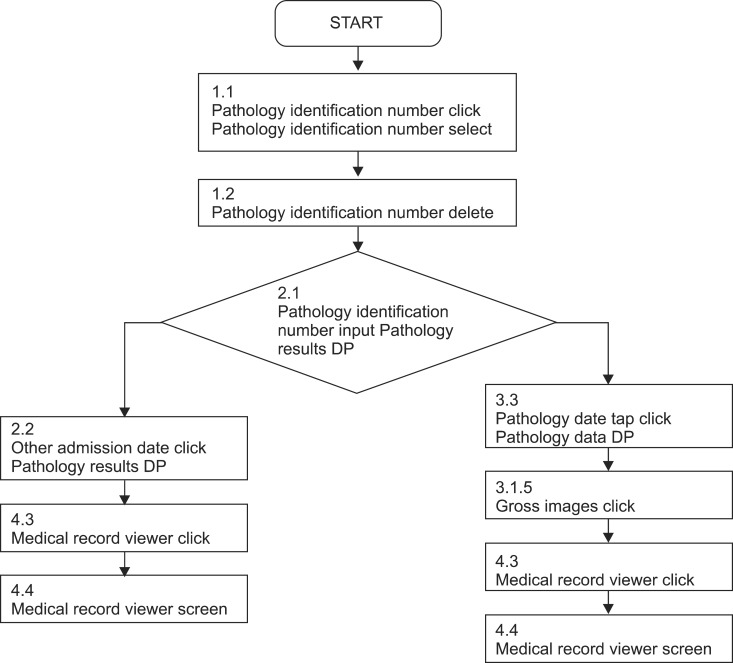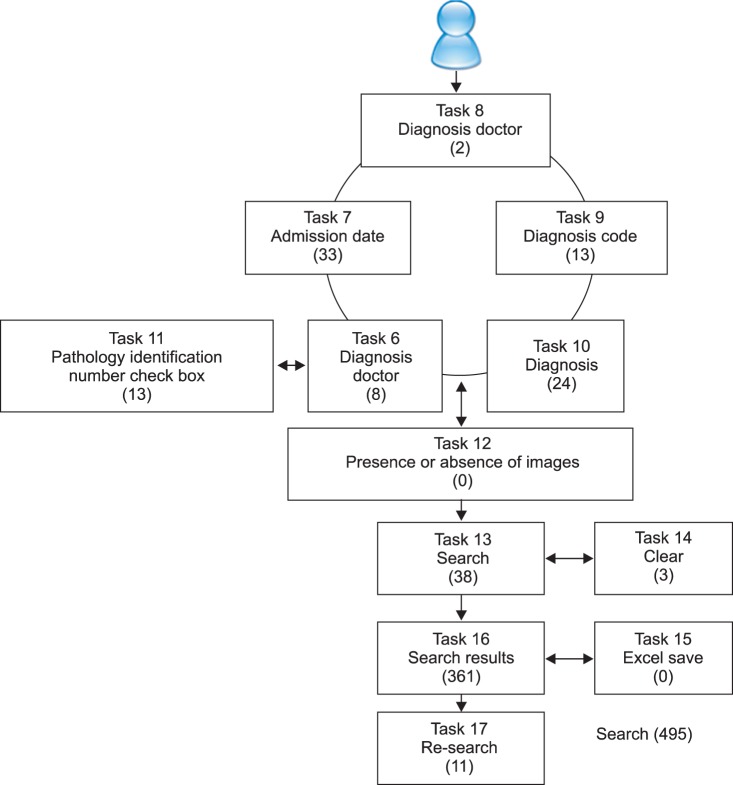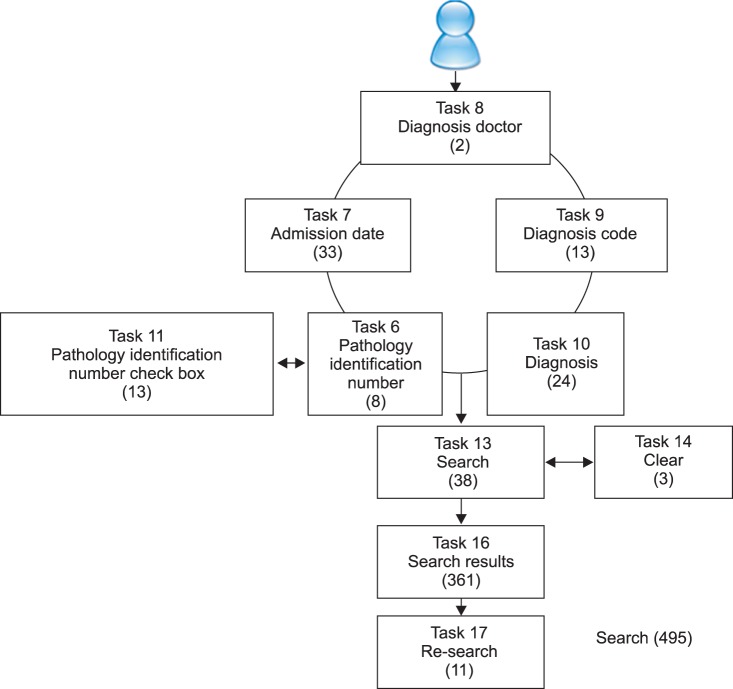Study on User Interface of Pathology Picture Archiving and Communication System
Article information
Abstract
Objectives
It is necessary to improve the pathology workflow. A workflow task analysis was performed using a pathology picture archiving and communication system (pathology PACS) in order to propose a user interface for the Pathology PACS considering user experience.
Methods
An interface analysis of the Pathology PACS in Seoul National University Hospital and a task analysis of the pathology workflow were performed by observing recorded video. Based on obtained results, a user interface for the Pathology PACS was proposed.
Results
Hierarchical task analysis of Pathology PACS was classified into 17 tasks including 1) pre-operation, 2) text, 3) images, 4) medical record viewer, 5) screen transition, 6) pathology identification number input, 7) admission date input, 8) diagnosis doctor, 9) diagnosis code, 10) diagnosis, 11) pathology identification number check box, 12) presence or absence of images, 13) search, 14) clear, 15) Excel save, 16) search results, and 17) re-search. And frequently used menu items were identified and schematized.
Conclusions
A user interface for the Pathology PACS considering user experience could be proposed as a preliminary step, and this study may contribute to the development of medical information systems based on user experience and usability.
I. Introduction
Recently, the rapid changes in information technology and computer technology have brought changes in general hospital management including patient management, general administration, clinical examination, healthcare management, information management, and the storage and delivery of medical images. Moreover, the variety of medical information systems, such as Electronic Medical Record (EMR) systems, Order Communication Systems (OCSs), and Picture Archiving and Communication Systems (PACS), as well as telemedicine has been developing rapidly.
Even though the introduction of various medical information systems has increased, the development of a user experience-based medical information system should be considered because various studies on the healthcare systems have focused mainly on functional aspects rather than on user experience. User experience refers to the overall experience that is gained from direct and indirect use of a system, product, or service, and is a new approach to developing the technology in terms of improving the quality of life rather than effectiveness alone [1-3]. In the information technology sector, user experience is considered to improve systems, products or services through the participation and observations of users [4]. To improve systems, task analysis is often applied. Task analysis is the process of analyzing how a user can perform their work using a system. Task analysis methods include hierarchical task analysis, knowledge-based analysis, scenario analysis, use case analysis, and workflow analysis [5-7].
PACS is a medical information system for the acquisition, storage, transmission, and retrieval of medical images [8]. In particular, the Pathology PACS is an integrated pathology management system for the storage, retrieval, interpretation, and output of pathology images and data. The ultimate objective of using a PACS is to establish a filmless hospital system. For this purpose, technology for the display and processing of images, information management, networking, databases, user interface, and information storage should be integrated [9].
However, it is necessary to consider upgrading the Pathology PACS considering user experience because the Pathology PACS has been developed mostly on the basis of functional aspects. Pathologists interact with the Web-based Pathology PACS throughout the workday; therefore, the Pathology PACS should be improved to enhance the workflow efficiency in pathology. The purpose of this study was to propose a user interface for the Pathology PACS based on user experience, which may contribute to improving the usability of the Pathology PACS.
II. Methods
As a preliminary step, an interface analysis of the Pathology PACS which is a part of Integrated Pathology Information Management System (iPIMS) at Seoul National University Hospital in Seoul, Korea, and a task analysis of the pathology workflow observing recorded video were performed. Based on the results obtained from this study, a user interface for the Pathology PACS is proposed.
1. Subjects
Nine pathologists regardless of gender participated in this study.
2. Integrated Pathology Information Management System
HUPAX is implemented in SNUH with the succession of human, ubiquitous, pathological, accessible and extendable iPIMS. The iPIMS made by HuminTec Co., Ltd. in Korea is an upgraded Pathology PACS, which enables integration with an EMR system, an OCS, a digital gross photography system, a gross photography recording system, a virtual slide image management system, a microscope photography system, and a 1:1 slide scanning system.
3. Pathology PACS Configuration
The menu structure of the Pathology PACS comprises the following items: pathology report, search, images search, public library, updating number of images, bug report, suggestion, library setting and log out.
The menu bar is located on the top of the pathology report screen. At the upper left side of the window, there is an input box for pathology identification number input. The bottom left side is for the choice of categories, including patient information, clinical examination, and diagnosis integrated with the EMR and OCS. Input or choice of the information shown on the left side box can provide pathology results and relevant information from the right side large box.
The next commonly used search interface is for searching and comparing the information through a combination of search criteria, such as pathology identification number, date of admission, the Systematized Nomenclature of Medicine (SNOMED) code, patient identification number, patient name, and diagnosis name.
III. Results
1. Task Analysis
In this study, a task analysis was performed for the user experience-centered assessment of the Pathology PACS as a preliminary step. Two analysis methods, including hierarchical analysis and workflow analysis were used in this study. The Pathology PACS task analysis was conducted using 128 video-recorded images on the basis of the frequency and importance degree of each function [6,10].
To identify the overall workflow pattern at the task segmentation, the Pathology PACS task analysis was performed in order by observing screen images of users' workflow, classifying time flow and screen change, and organizing Excel files. Based on the analysis of frequently used screen displays including pathology report displayed on the first screen and search category selected from the menu, the task was proposed as shown in Figure 1.
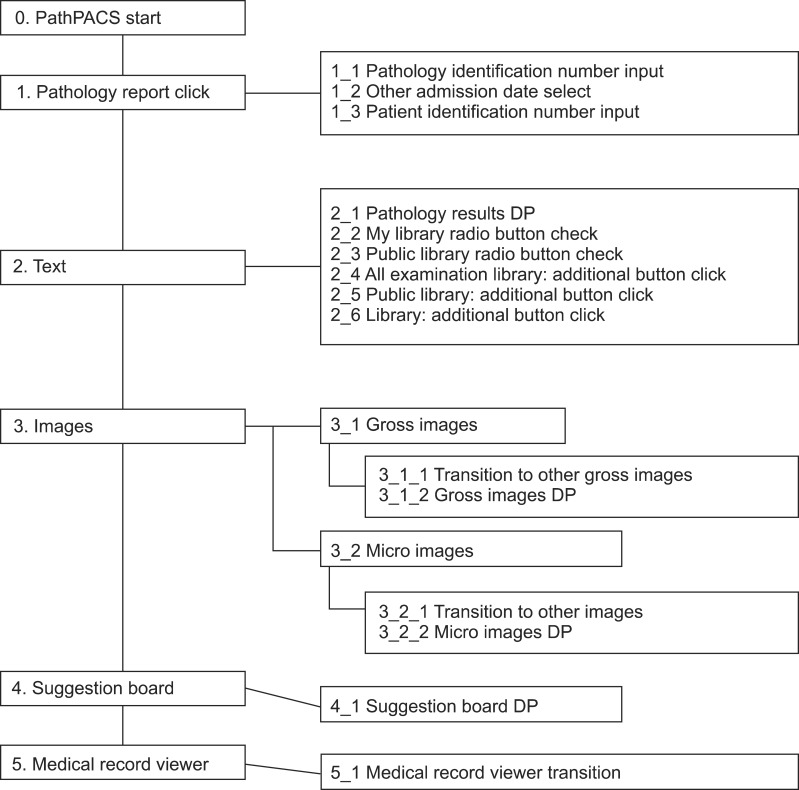
Hierarchical task analysis. PathPACS: pathology picture archiving and communication system, DP: display picture.
For the first task analysis, frequently used pathology report and search categories were analyzed (Table 1). For the second task analysis, more detailed behaviors were analyzed by grouping each task belonging to related work or work requiring similar behavior, and the behavior of using input devices, such as a barcode reader, keyboard, or mouse (mouse, wheel, etc.) was analyzed (Table 2).
Hierarchical task analysis of the Pathology PACS by observing recorded video of pathology workflow could be classified into 17 tasks: 1) pre-operation, 2) text, 3) images, 4) medical record viewer, 5) screen transition, 6) pathology identification number input, 7) admission date input, 8) diagnosis doctor, 9) diagnosis code, 10) diagnosis, 11) pathology identification number check box, 12) presence or absence of images, 13) search, 14) clear, 15) Excel save, 16) search results, and 17) re-search [11,12].
2. Workflow of Pathology Report Interface
The pathologist workflow of using the Pathology PACS and frequently used menu items were identified and schematized by hierarchical task analysis of the Pathology PACS.
Workflow analysis was carried out to identify the organization, subject, motivation, procedure, information flow, and tracking of the work. The pathologists who participated in this study began to work using the pathology report screen as an initial step. The workflow analysis by task category using SPSS ver. 18.0 (SPSS Inc., Chicago, IL, USA) demonstrated that the frequency numbers of the pathology report, search, image search, my library, common library, and image update functions were 1,301, 495, 1, 7, 11, and 1, respectively (Figure 2).
Figure 3 shows a list of tasks with high frequency numbers in the pathology report function, illustrating a simple menu structure after the integration of menu items with similar function, low frequency of use numbers, and deleted unnecessary menu items.
The frequency numbers of task 1, task 2, task 3, task 4, and task 5 were 301, 524, 390, 178, and 86, respectively (Figure 4). Based on this workflow analysis, a general workflow of using the pathology report function could be proposed as shown in Figure 5.
3. Workflow of Search Interface
Tasks were classified into task 6 for pathology identification number, task 7 for admission date, task 8 for doctor name, task 9 for diagnosis code, task 10 for diagnosis, task 11 for check box, task 12 for presence or absence of images, task 13 for search, task 14 for clear, task 15 for Excel save, task 16 for search results, and task 17 for re-search results.
The frequency numbers of task 6, task 7, task 8, task 9, task 10, task 11, task 12, task 13, task 14, task 15, task 16, and task 17 were 8, 33, 2, 13, 24, 13, 0, 38, 3, 0, 361, and 11, respectively (Figure 6). As shown in Figure 6, it was observed that the frequent workflow steps to obtain pathology results were inputting the diagnosis name or code, and then searching after checking and/or changing the admission date. The speed of the search workflow was slower than that of the pathology report function, and it was found that it was difficult to identify the text and list of pathology results. After the study, a search task could be proposed as shown in Figure 7.
IV. Discussion
This study analyzed the basic information, such as screen configurations and task definitions, of the Web-based Pathology PACS, and proposed a user interface for the Pathology PACS based on user experience as a preliminary step. In recent years, even though various forms of medical information systems have been developed and used in hospitals, working efficiency has not been improved due to difficulties in interface use in relation to screen or menu configurations.
In this study, the menu configuration and major functions of the Pathology PACS were studied in a screen configuration analysis. Then, a preliminary study was performed by selecting frequently used tasks in pathology to establish an experimental plan. Finally, as a process of experimental design, the workflow interface was derived.
In this study, a hierarchical task analysis of the Pathology PACS was carried out. The main reason to use a hierarchical task analysis for this study was to prevent disadvantages from using other types of task analysis such as knowledge-based analysis, scenario analysis and use case analysis. The Pathology PACS task analysis was performed using video-recorded images of pathologists' workflow. Pathology report was classified into task 1 for pre-operation work, task 2 for text, task 3 for images, and task 4 for medical record viewer and screen transition. The pathologists' workflow was summarized as follows:
1) The steps of the work process were the following: inputting pathology identification number and then reading pathology results and date. The most frequent workflow included the use of the medical records viewer and hospital computer system after or before using pathology data.
2) The workflow of the pathology report function included performing text work, identifying pathology results, and reviewing gross and microscope images. After reviewing pathology results, necessary information was obtained by integrating the medical record viewer.
3) The speed of the work process was generally fast, and it was similar to the speed of common work processes.
4) Alternative ways to obtain pathology results were found, namely, by identifying the list of search results and necessary information after displaying search results, or identifying pathology results by using the pathology report function.
5) The workflow analysis demonstrated the high frequency of mouse use for changing the task, reducing work efficiency due to the location of frequently used menu items, and the possibility of errors being caused by the repetition of specific work.
The Pathology PACS task analysis could classify the tasks into two levels, top and bottom levels. It was found that top-level tasks of major functions included pathology report, search, my library, and public library. Detailed task analysis indicated that the most frequently used tasks were pathology report and search; the pathology report task could be divided into 5 tasks, and the search task could be divided into a total of 10 tasks. From the observation and analysis of the pathology workflow, it was possible to organize a detailed workflow using the Pathology PACS based on factors, such as task frequency, task relationship, and task importance.
Based on this study, a more efficient screen configuration and the relationship between component configurations for the accurate and efficient use of the Pathology PACS by pathologists could be identified. It is expected that this preliminary study to improve the user interface of the Pathology PACS based on user experience may contribute to the development of medical information systems considering user experience and usability.
Acknowledgments
This research was supported by the National Research Foundation of Korea grant funded by the Korea Government (No. 2010-0028631).
Notes
No potential conflict of interest relevant to this article was reported.

